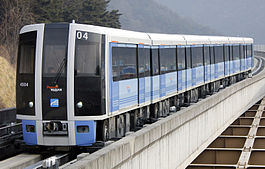Busan_Metro_Line_4
Busan Metro Line 4
Rubber-tyred subway line in Busan, South Korea
Busan Metro Line 4 (4호선) is a rubber-tyred metro line of the Busan Metro network that connects part of Gijang-gun, Busan, and upper Haeundae-gu, Busan, into Dongnae-gu, Busan Korea. It is operated by the Busan Transportation Corporation. Opened on 30 March 2011,[1] the line is a rapid transit (metro) system consisting of 14 stations - 8 underground, 1 on-ground, and 5 above-ground.[2] The line color is blue. A trip through the entire line takes about 24 minutes. Unlike lines 1 to 3 of Busan Metro, the trains are driverless and run with pneumatic tires on concrete track (Roll way) between two guide bars. Line 4 was originally planned to be simply a branch of Line 3 (similar to Seoul Subway Line 2's Sinjeong and Seongsu branches), but was turned into its own line later.
This article needs additional citations for verification. (December 2015) |
Line 4's station signs have blue frames, sharing their design with the station sign design used in some stations of Line 1, such as Seomyeon and Dongnae. Their main body is white and circled by a blue frame and the station name is printed in big Hangul near the top with smaller English and Hanja names near the bottom, with the English name having the station number beside it. The arm that points to the next station has that station's name in it and a pointed end, while the arm that has the previous station's name printed on it and points to that station has a concave indent.
